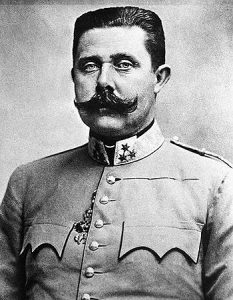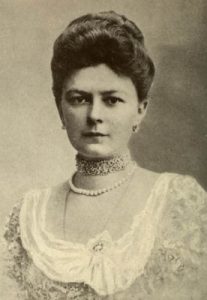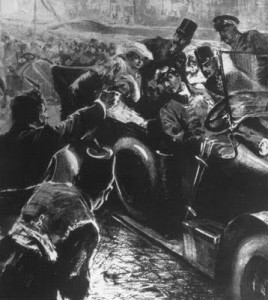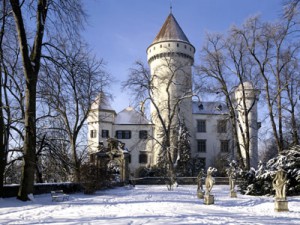Archduke Franz Ferdinand of Austria
By Tracy A. Burns
Becoming heir to the Habsburg throne
 Born in Graz, Austria on December 18, 1863, Franz Ferdinand was the eldest son of Archduke Karl Ludwig of Austria, the brother of Franz Joseph. In 1889 his cousin, the Emperor’s son, Crown Prince Rudolf killed himself, and then in 1896, his father succumbed to typhoid. Franz Ferdinand found himself heir to the throne.
Born in Graz, Austria on December 18, 1863, Franz Ferdinand was the eldest son of Archduke Karl Ludwig of Austria, the brother of Franz Joseph. In 1889 his cousin, the Emperor’s son, Crown Prince Rudolf killed himself, and then in 1896, his father succumbed to typhoid. Franz Ferdinand found himself heir to the throne.
Military career and hobbies
The Archduke had a distinguished military career, gaining promotions to captain, major, colonel, and general. In 1913 he was named Inspector General of Austria-Hungary’s Army. An avid supporter of the Empire’s Navy, Franz Ferdinand has been described as energetic, reckless, proud, mistrusting, and moody. Obsessed with hunting, he acquired approximately 300,000 hunting trophies. Some 5,000 of them came from deer. He had another hobby as well – collecting antiques. Now, some 100,000 of his trophies and many of his antiques are on display at Konopiště Chateau, near Benešov, not far from Prague.
Franz Ferdinand’s political stance
The Archduke’s relationship with Emperor Franz Josef was laden with friction. Often disagreeing with the Empire’s leaders, he was not very popular. Politically, Franz Ferdinand aligned himself with centralism and Catholic conservatism. Striving to give more freedom to ethnic groups in the Austro-Hungarian Empire, he supported the Czechs as well as the Croatians and Bosnians. The Archduke also promoted federalism that would make the empire into 16 states and saw Hungarian nationalism as a serious threat. He also believed that if Serbia was treated harshly, Russia would react violently.
Smitten by Sophie
 A life-changing event occurred in 1894 when the heir to the throne met Countess Sophie Chotek, who served as a lady-in-waiting to Archduchess Isabella, at a ball in Prague. Smitten, the two lovebirds were forced to keep their relationship a secret for two years because Sophie’s family members were not descendants of the Habsburgs or of any other European ruling dynasties, making her ineligible to marry someone of the Archduke’s status. Stubborn and determined, Franz Ferdinand refused to marry anyone else. Supported by other rulers and the Pope, the Archduke finally got Emperor Franz Joseph’s permission to marry Sophie in 1899. Yet the Emperor set down some harsh conditions. The couple’s offspring would not be heirs to the throne. Sophie was also forbidden to sit in the royal carriage or royal box. Undeterred, the couple tied the knot on July 1, 1900, at Zákupy Chateau in northern Bohemia near the German border. The Emperor, his brothers, and their families refused to attend the ceremony. Sophie was given the title of Princess of Hohenberg and Duchess of Hohenberg. They had three children – Princess Sophie von Hohenberg (1901); Maximilian, Duke of Hohenberg (1902); and Prince Ernst von Hohenberg (1904).
A life-changing event occurred in 1894 when the heir to the throne met Countess Sophie Chotek, who served as a lady-in-waiting to Archduchess Isabella, at a ball in Prague. Smitten, the two lovebirds were forced to keep their relationship a secret for two years because Sophie’s family members were not descendants of the Habsburgs or of any other European ruling dynasties, making her ineligible to marry someone of the Archduke’s status. Stubborn and determined, Franz Ferdinand refused to marry anyone else. Supported by other rulers and the Pope, the Archduke finally got Emperor Franz Joseph’s permission to marry Sophie in 1899. Yet the Emperor set down some harsh conditions. The couple’s offspring would not be heirs to the throne. Sophie was also forbidden to sit in the royal carriage or royal box. Undeterred, the couple tied the knot on July 1, 1900, at Zákupy Chateau in northern Bohemia near the German border. The Emperor, his brothers, and their families refused to attend the ceremony. Sophie was given the title of Princess of Hohenberg and Duchess of Hohenberg. They had three children – Princess Sophie von Hohenberg (1901); Maximilian, Duke of Hohenberg (1902); and Prince Ernst von Hohenberg (1904).
The fateful invitation to Sarajevo
During the summer of 1914, as Inspector General of the Army, Franz Ferdinand accepted the invitation from General Oskar Potiorek to watch, along with his wife Sophie, military maneuvers in Sarajevo, the capital of Bosnia. The couple was aware that it would be a dangerous undertaking. When Austria annexed Bosnia and Herzegovina in 1908, it stirred an unsettling reaction from the West, and many Serbians wanted a Pan-Slav state directed by Serbia, a province that had better relations with Russia than with Austro-Hungary. Clashes with the Habsburg Empire involved a dispute over customs in 1906 and stormy protests over Austro-Hungarian’s annexation of Bosnia-Herzegovina during the troubled times of 1908 and 1909. The two Balkan Wars of 1912 and 1913 added more friction as Serbia conquered Macedonia and Kosovo. The six Bosnian Serbs assigned to assassinate Franz Ferdinand strove to liberate the south-Slav provinces from Habsburg rule in order to create a Greater Serbia or Yugoslavia.
June 28, 1914: The first attempt
On June 28, 1914, Archduke Franz Ferdinan d‘Este and his wife Duchess of Hohenberg arrived in Sarajevo by train shortly before 10 am. Going to City Hall for the official reception, the royal couple took seats with two others in the third car of a six-vehicle motorcade as six Bosnian Serb assassins, three of which were associated with the Black Hand terrorist group, readied themselves along the route that the Gräf & Stift open sports car was to take. A little after 10 am, as the car passed the central police station, assassin Vaso Čubrilović hurled a hand grenade at the car. While it missed its target, bouncing off the folded back of the convertible cover and rolling into the street, the bomb did a lot of damage, injuring 20 people as it exploded under the fourth car in the procession. As the five cars continued toward the Town Hall, 19-year-old Gavrilo Princip and two others did nothing when it was their turn to act because the car was moving too fast. It seemed as if the assassination attempt on Franz Ferdinand had been a failure.
The assassination
 Then the Archduke and Duchess decided to change their plans and visit the injured at the hospital. Not informed that they were taking a different route, the driver of the third car took a wrong turn onto Franz Joseph Street and had to back up near the Latin Bridge. That is when fate intervened. Princip was just coming out of Schiller’s delicatessen when the Archduke’s vehicle stalled nearby. At 10:45 am, only one and a half meters away, Princip fired his Belgian semi-automatic pistol. The Archduke was hit in the jugular vein while Princip shot Sophie in the abdomen. Franz Ferdinand begged Sophie not to die, telling her to live for their children. Then Lieutenant Colonel Count Franz von Harrach, also seated in the Double Phaeton vehicle, asked the Archduke if he was badly hurt. The heir to the throne repeated, “It’s nothing,” six or seven times before his plumed hat fell off and he crumpled in the car. Princip was soon arrested, while the vehicle sped to the Governor’s residence for first aid. The Archduke’s soul mate was dead on arrival, and the heir to the Habsburg throne succumbed 10 minutes later. World War I would begin less than two months after their deaths. Franz Ferdinand was buried in the chapel crypt of his Artstetten Castle in Lower Austria. Emperor Franz Joseph and the German Emperor Wilhelm II were notably absent from the funeral.
Then the Archduke and Duchess decided to change their plans and visit the injured at the hospital. Not informed that they were taking a different route, the driver of the third car took a wrong turn onto Franz Joseph Street and had to back up near the Latin Bridge. That is when fate intervened. Princip was just coming out of Schiller’s delicatessen when the Archduke’s vehicle stalled nearby. At 10:45 am, only one and a half meters away, Princip fired his Belgian semi-automatic pistol. The Archduke was hit in the jugular vein while Princip shot Sophie in the abdomen. Franz Ferdinand begged Sophie not to die, telling her to live for their children. Then Lieutenant Colonel Count Franz von Harrach, also seated in the Double Phaeton vehicle, asked the Archduke if he was badly hurt. The heir to the throne repeated, “It’s nothing,” six or seven times before his plumed hat fell off and he crumpled in the car. Princip was soon arrested, while the vehicle sped to the Governor’s residence for first aid. The Archduke’s soul mate was dead on arrival, and the heir to the Habsburg throne succumbed 10 minutes later. World War I would begin less than two months after their deaths. Franz Ferdinand was buried in the chapel crypt of his Artstetten Castle in Lower Austria. Emperor Franz Joseph and the German Emperor Wilhelm II were notably absent from the funeral.
The trials and the Terezín Fortress
All the assassins were arrested and tried from October 12 to October 23, 1914. Three of the assassins, including Princip, could not be sentenced to death because they were less than 20 years of age. On October 28, 1914, Princip, who stated in the courtroom that he believed in unifying all south-Slav states and freeing them from Austro-Hungary’s grip, received a 20-year punishment, the maximum sentence for someone his age. Princip, who died of tuberculosis in prison, would be incarcerated in central Bohemia’s Terezín fortress.
World War I
Austria-Hungary lashed out at Serbia, giving them an ultimatum and breaking diplomatic ties. Other nations soon joined sides in the furious fray, triggering World War I that initially put the Central Powers of Germany and Austria-Hungary against the Allies of Serbia – the United Kingdom, France, and Russia. While many factors, such as nationalism and imperialism, contributed to the causes of The Great War, the assassination of Franz Ferdinand and his wife played a major role in instigating the sixth deadliest conflict in world history, a war that would take the lives of more than 9 million soldiers from July 28, 1914, to November 11, 1918.
Konopiště Chateau and the museum artifacts from the assassination
 The bullet that killed Franz Ferdinand is on display at Konopiště Chateau near Prague. Princip’s pistol and the Double Phaeton in which the Archduke and Duchess had been riding can be seen at the Museum of Military History in Vienna, Austria. Franz Ferdinand’s bloodstained light blue uniform and plumed hat along with the chaise longue on which he expired are there, too.
The bullet that killed Franz Ferdinand is on display at Konopiště Chateau near Prague. Princip’s pistol and the Double Phaeton in which the Archduke and Duchess had been riding can be seen at the Museum of Military History in Vienna, Austria. Franz Ferdinand’s bloodstained light blue uniform and plumed hat along with the chaise longue on which he expired are there, too.




